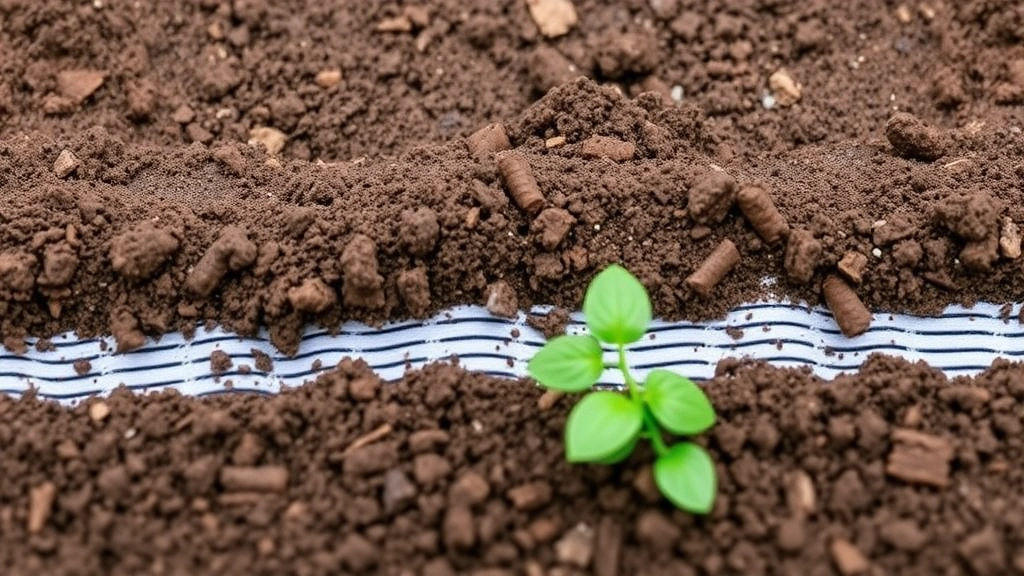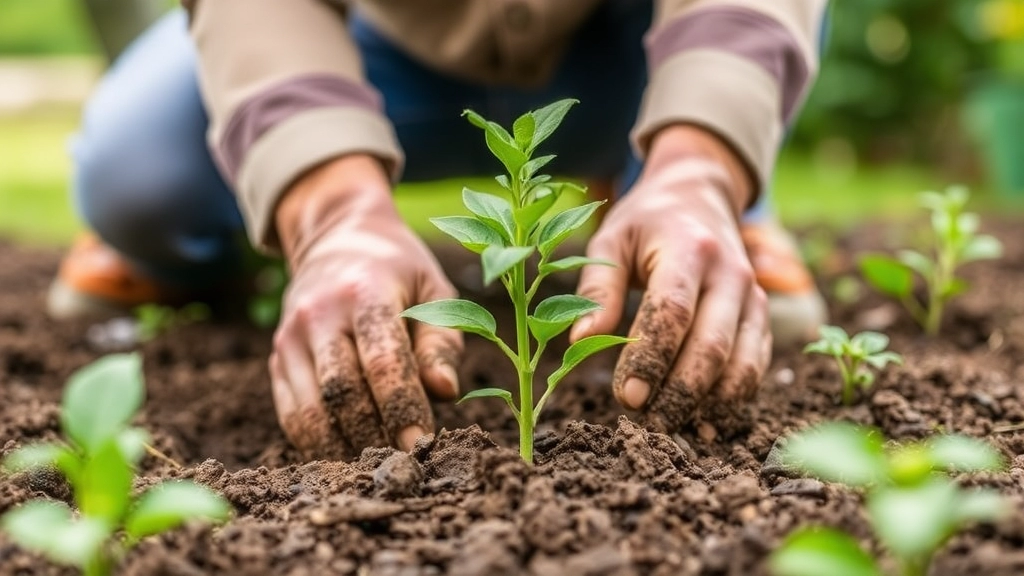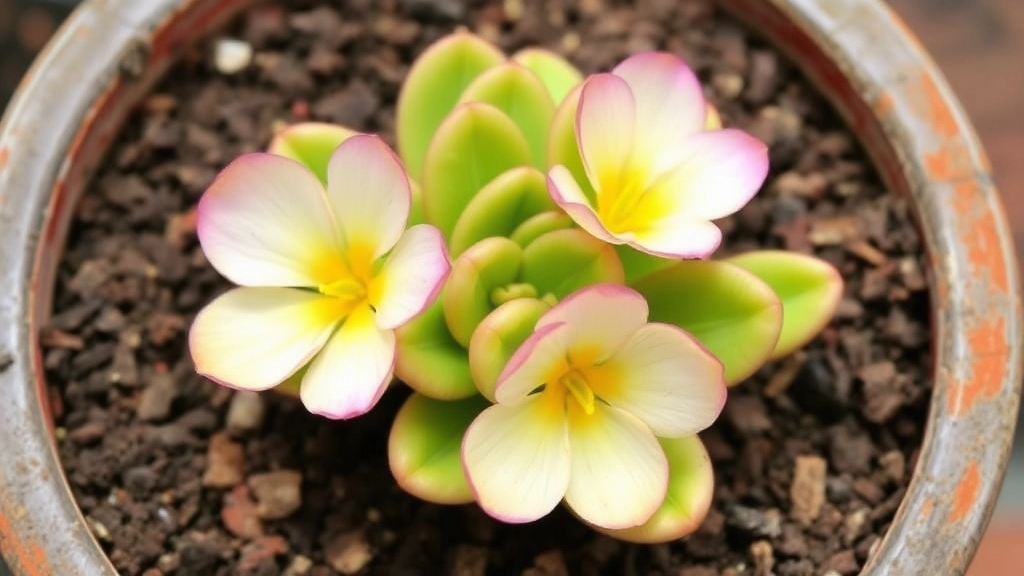Growing Kalanchoe Blossfeldiana
If you’re looking to grow Kalanchoe blossfeldiana, getting the soil right is crucial. This succulent thrives in well-draining soil that mimics its natural habitat. A mix of cactus soil and perlite is ideal, ensuring your Kalanchoe gets the aeration it needs while preventing root rot.
Importance of Proper Drainage
Proper drainage is key for Kalanchoe blossfeldiana soil. Make sure your pot has drainage holes and avoid compacting the soil. This helps excess water escape, keeping the roots healthy.
DIY Soil Mix
For a DIY approach, mix equal parts of potting soil, sand, and perlite to create the perfect environment for your Kalanchoe to flourish.
Ideal Soil Composition for Kalanchoe Blossfeldiana
When caring for Kalanchoe Blossfeldiana, one of the most common concerns is the right soil composition.
What makes the ideal soil for this vibrant succulent?
Kalanchoe thrives in a well-draining, nutrient-rich environment.
Here’s a breakdown of the ideal soil components:
- Cactus Mix: A pre-packaged cactus mix is a great starting point. It provides the drainage needed for succulents.
- Perlite: Adding perlite enhances aeration and drainage. Aim for about 20-30% of your mix.
- Coarse Sand: Incorporating coarse sand improves drainage further. A mix of 10-20% is beneficial.
- Organic Matter: A small amount of organic matter, like compost, can provide essential nutrients without retaining excess moisture.
- pH Level: Kalanchoe prefers a slightly acidic to neutral pH, ideally between 6.0 and 7.0.
By combining these elements, you create a soil mix that promotes healthy growth and vibrant blooms. For more detailed care guidelines, check out our Complete Care Guide for Kalanchoe Blossfeldiana. Additionally, understanding the flowering period care tips can help you maintain your plant’s vibrant appearance.
Importance of Proper Drainage in Soil

So, you’ve got your Kalanchoe Blossfeldiana and you’re excited about growing it, right? But have you thought about drainage?
Proper drainage is crucial for the health of your plant. If the soil retains too much water, your Kalanchoe can suffer from root rot. That’s a nightmare for any plant parent!
Here’s why drainage is a big deal:
- Prevents Root Rot: Standing water can lead to mushy roots, which is a one-way ticket to plant death.
- Promotes Healthy Growth: Well-drained soil encourages roots to grow deep and strong, making your plant more resilient.
- Reduces Pests: Excess moisture can attract pests like fungus gnats. Nobody wants those little nuisances hanging around!
To ensure your Kalanchoe thrives, consider these tips:
- Use Pots with Drainage Holes: Always choose pots that allow excess water to escape.
- Layering: Add a layer of gravel or small stones at the bottom of your pot. This helps water flow out easily.
- Soil Type: Opt for a soil mix designed for succulents. These usually contain sand or perlite for better drainage.
How to Create a DIY Kalanchoe Soil Mix
Creating the perfect soil mix for your Kalanchoe Blossfeldiana is essential for its health and vibrancy. You might be wondering, “What ingredients do I need?” or “How can I ensure my plant thrives?” Don’t worry; I’ve got you covered.
Avoiding Soil Compaction and Ensuring Aeration

Many plant enthusiasts worry about soil compaction and its impact on their Kalanchoe Blossfeldiana. Compacted soil can lead to poor drainage and hinder root development, ultimately affecting the plant’s health.
To keep your Kalanchoe thriving, consider these essential tips:
- Choose the Right Ingredients: Use a mix of potting soil, perlite, and coarse sand. This combination allows for better drainage and air circulation.
- Avoid Overwatering: Too much water can cause the soil to become compacted. Ensure you only water when the top inch of soil feels dry.
- Use a Well-Draining Pot: Opt for pots with drainage holes to prevent water from sitting at the bottom, which can lead to compaction.
- Gently Loosen Soil: When you repot, gently aerate the soil by using a fork or your fingers to break up any compacted areas.
- Regularly Check Soil Condition: Monitor your soil for signs of compaction. If it feels hard or dense, it may be time to refresh your mix.
By ensuring proper aeration and avoiding compaction, your Kalanchoe will have the best chance to flourish.
Maintaining the Right Soil pH for Optimal Growth
Are you concerned that your Kalanchoe Blossfeldiana isn’t thriving as it should? One crucial factor that might be affecting its growth is soil pH.
Kalanchoe plants prefer slightly acidic to neutral soil, ideally with a pH range of 6.0 to 7.0. Maintaining the right pH is essential for nutrient absorption, which directly influences the health and vibrancy of your plant.
Why pH Matters:
- Nutrient Availability: The right pH ensures that essential nutrients like nitrogen, phosphorus, and potassium are readily available for uptake.
- Disease Resistance: Proper pH levels can help prevent soil-borne diseases that may affect your plant’s health.
How to Check Soil pH:
- pH Test Kits: Affordable and easy to use, these kits can provide an accurate reading of your soil’s acidity.
- pH Meters: For those seeking precision, digital pH meters offer a quick and reliable way to measure soil pH.
Adjusting Soil pH:
- To Lower pH: Incorporate materials like peat moss or sulphur to make the soil more acidic.
- To Raise pH: Add lime or wood ash to increase alkalinity.
Regular Monitoring:
Check the pH every few months, especially after repotting or changing your soil mix. This will help you stay ahead of any potential issues. For more detailed tips, you can refer to our Optimal Care for Kalanchoe Blossfeldiana Growth guide. Additionally, if you are interested in propagation methods, our article on How to Propagate Kalanchoe Blossfeldiana Cuttings may be helpful.
Seasonal Soil Care and Repotting Tips
So, you’ve got your Kalanchoe Blossfeldiana thriving, but how do you keep that momentum going through the seasons?
Seasonal Soil Care
As the seasons change, so do the needs of your plant. Here’s what to keep in mind:
- Spring: This is the perfect time to check your soil. After the winter dormancy, your Kalanchoe is ready to grow. Refresh the top layer of soil to provide fresh nutrients.
- Summer: Keep an eye on moisture levels. Hot weather can dry out your soil quickly, so ensure it’s well-draining. A quick poke test can help you gauge when to water.
- Autumn: As growth slows, reduce watering. This is also a good time to inspect for pests or diseases that might have snuck in during the warmer months.
- Winter: Your Kalanchoe will appreciate a break. Keep it in a cooler spot with less light and cut back on watering. This helps prevent root rot.
Repotting Tips
Now, let’s talk repotting. When should you do it?
- Signs It’s Time to Repot: If roots are growing out of the drainage holes or the plant looks top-heavy, it’s time for a new pot.
- Best Time to Repot: Spring is ideal. The plant is waking up, and you’ll give it the best chance to adapt to its new home.
- How to Repot:
- Choose a pot that’s one size bigger.
- Use your DIY Kalanchoe soil mix for optimal drainage.
- Gently remove the plant, loosen any tightly bound roots, and place it in the new pot.
- Water lightly to settle the soil.
By keeping these seasonal tips in mind, your Kalanchoe will be primed for healthy growth all year round. For more detailed care tips, check out our Optimal Care for Kalanchoe Blossfeldiana Growth guide. If you’re interested in expanding your collection, discover the best deals and varieties in our Kalanchoe Blossfeldiana for Sale section.
Frequently Asked Questions (FAQs) about Kalanchoe Blossfeldiana Soil
Why is proper drainage important for Kalanchoe Blossfeldiana?
Proper drainage is essential for the health of your Kalanchoe Blossfeldiana. If the soil retains too much water, it can lead to root rot, which is detrimental to the plant. Good drainage prevents root rot, promotes healthy growth, and reduces pests.
What can I do to ensure proper drainage for my Kalanchoe?
To ensure proper drainage, use pots with drainage holes, add a layer of gravel or small stones at the bottom of the pot, and opt for a soil mix designed for succulents, which usually contains sand or perlite.
How does soil compaction affect Kalanchoe Blossfeldiana?
Soil compaction can lead to poor drainage and hinder root development, ultimately affecting the plant’s health. Compacted soil restricts air circulation and can cause water to sit at the bottom of the pot, leading to root problems.
What are the best soil ingredients for Kalanchoe Blossfeldiana?
Use a mix of potting soil, perlite, and coarse sand. This combination allows for better drainage and air circulation, which are crucial for the plant’s health.
How can I avoid overwatering my Kalanchoe?
To avoid overwatering, only water your Kalanchoe when the top inch of soil feels dry. Overwatering can cause the soil to become compacted and lead to root issues.
What type of pot should I use for my Kalanchoe Blossfeldiana?
Opt for pots with drainage holes to prevent water from sitting at the bottom, which can lead to soil compaction and root rot.
How can I maintain good soil aeration for my Kalanchoe?
To maintain good soil aeration, gently loosen the soil when repotting by using a fork or your fingers to break up any compacted areas. Regularly check the soil condition and refresh the mix if it feels hard or dense.
How often should I check the soil condition of my Kalanchoe?
Regularly monitor your soil for signs of compaction. If the soil feels hard or dense, it may be time to aerate it or refresh your soil mix to ensure healthy growth.
References
-
The Spruce: Growing Kalanchoe Indoors
-
Gardening Know How: Kalanchoe Plant Care
-
The Old Farmer’s Almanac: Kalanchoe
